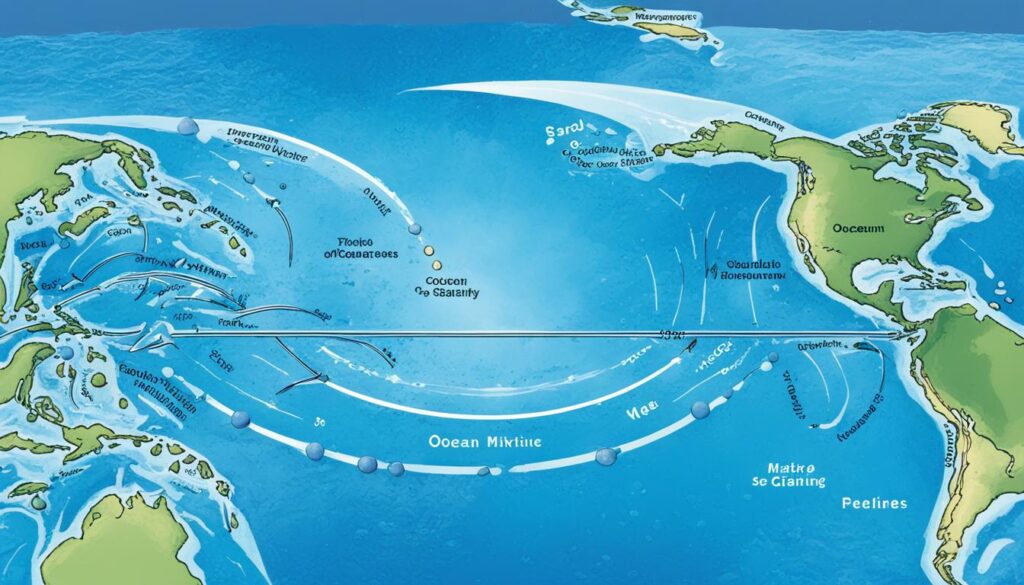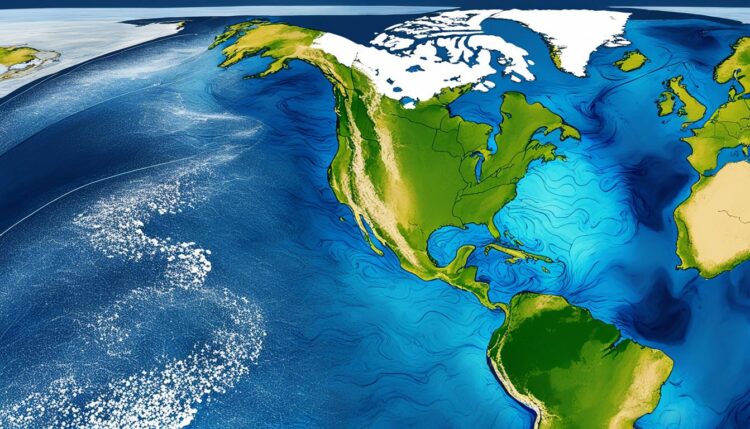Various online videos have spurred the misconception that the Atlantic and Pacific Oceans don’t mix, often showing stark contrasting lines between different water types. Oceanographer Nadín Ramírez explains that while these oceans do engage in mixing, the rates and locations of this process vary due to factors like salinity, temperature, and climate changes. Key mixing zones such as the Strait of Magellan and the turbulent Drake Passage, where waves can reach up to 60 feet, play a significant role in this phenomenon.
In addition, dynamic layers of water, known as clines, and global currents facilitate both the mixing and exchange of waters between these vast bodies. Ultimately, the intricate dynamics of oceanography, ocean boundaries, and ocean dynamics influence how and where the Atlantic and Pacific Oceans intermingle.
Key Takeaways
- The misconception stems from online videos showing clear boundaries between the Atlantic and Pacific Oceans.
- Oceanographer Nadín Ramírez emphasizes that these oceans do mix, albeit variably.
- Factors like salinity, temperature, and climate changes impact ocean mixing.
- The Strait of Magellan and Drake Passage are critical mixing zones.
- Dynamic water layers and global currents aid in the exchange of oceanic waters.
Introduction to the Atlantic and Pacific Oceans
The world’s oceans are vast and mysterious, each with unique features that contribute to global seas’ overall complexity. The Pacific Ocean, known as the largest and deepest of the global seas, spans approximately 165 million square kilometers with an average depth of 4,280 meters. In contrast, the Atlantic Ocean covers around 107 million square kilometers and averages at 3,646 meters deep.
These oceanic characteristics highlight the massive scale and depth differences between the two bodies of water. Despite these distinct features, there is a constant exchange of water between the oceans, driven by currents. This movement ensures that, while the Pacific and Atlantic maintain different oceanic traits such as varying salinity levels, they are part of the same continuous system. This integration of the world’s oceans underscores the interconnectedness of global seas, blurring the lines between individual oceanic pools.
Ocean Currents and Their Role
Ocean currents play a pivotal role in the movement and mixing of ocean water. They are generated by a variety of forces acting upon the water, including wind, temperature gradients, and differences in water density.
What are Ocean Currents?
Ocean currents are continuous, directed movements of seawater generated by the forces such as wind, Coriolis effect, temperature, and salinity differences. These currents are essential components of the Earth’s climate system as they help distribute heat worldwide.
Types of Ocean Currents
Ocean currents are categorized into surface currents and deep ocean circulation. Surface currents, located in the upper 400 meters of the ocean, are primarily driven by wind patterns. Notable examples include the Gulf Stream and the Kuroshio Current. Meanwhile, deep ocean circulation, often referred to as the global conveyor belt, is driven by differences in water density caused by variations in temperature and salinity. This circulation moves water slowly across the deep ocean basins.
Impact of Ocean Currents on Ocean Mixing
The dynamics of ocean currents significantly influence ocean mixing. Surface currents aid in the redistribution of thermal properties, enabling heat exchange between equatorial and polar regions. Furthermore, the global conveyor belt ensures the transfer of nutrients and gases between ocean layers. This complex interaction between surface currents and deep ocean circulation enhances the mixing of ocean water on a global scale, fostering a stable marine environment.
| Type of Current | Driven By | Key Example |
|---|---|---|
| Surface Currents | Wind Patterns | Gulf Stream |
| Deep Ocean Circulation | Temperature and Salinity Variations | Global Conveyor Belt |
Unique Properties of the Atlantic and Pacific Oceans
The Atlantic and Pacific Oceans, despite being vast bodies of interconnected water, exhibit distinct characteristics that set them apart. One such difference is in ocean salinity. The Atlantic Ocean boasts higher salinity levels compared to the Pacific due to various factors including higher rates of evaporation and the limited influx of lower salinity waters from the deep sea. This elevated salinity has implications for the marine life and aquatic ecosystems that thrive within these waters.
Ocean temperatures also vary between these two gigantic bodies of water. The Atlantic’s generally warmer waters, compared to the Pacific, are influenced by currents such as the Gulf Stream, which significantly impact the climate of adjacent landmasses. These temperature variations play a critical role in determining the biodiversity unique to each ocean.
Below is a comparative table illustrating the different properties:
| Property | Atlantic Ocean | Pacific Ocean |
|---|---|---|
| Ocean Salinity | Higher | Lower |
| Evaporation Rates | Higher | Lower |
| Influx of Deep Sea Water | Limited | More Frequent |
| Ocean Temperatures | Warmer | Cooler |
Understanding these unique properties helps in appreciating the complexities of aquatic ecosystems across the world’s oceans and highlights the importance of protecting these extraordinary environments.
Thermohaline Circulation
Thermohaline circulation is a critical component of the Earth’s oceanic system, driven by variations in temperature and salinity. This process plays a fundamental role in the movement of saline waters across the globe, influencing both deep water formation and overall climate regulation.
Definition and Importance
Thermohaline circulation, often referred to as the “global conveyor belt,” is a deep-ocean process influenced by temperature (thermal) and salinity (haline) gradients. This circulation is crucial for global climate regulation as it distributes heat and nutrients around the world’s oceans. It involves the sinking of dense, saline waters in polar regions, which then move horizontally through the deep ocean and eventually rise in warmer regions. This process is not just vital for deep water formation but also for maintaining the balance of oceanic ecosystems.
How Thermohaline Circulation Impacts Ocean Mixing
The impact of thermohaline circulation on ocean mixing is profound. As saline waters in the polar regions sink, they aid in the formation of deep water layers that travel long distances via the global conveyor belt. This movement ensures the continuous mixing of different water masses, balancing temperature and salinity levels globally. The process fosters a unique interaction between various ocean strata, significantly affecting ocean chemistry and aiding in climate regulation.
| Key Component | Role |
|---|---|
| Temperature Gradients | Influence the sinking and rising of water masses |
| Salinity Gradients | Determine water density and movement of saline waters |
| Deep Water Formation | Created by the sinking of dense saline waters in polar regions |
| Horizontal Movement | Deep water masses travel across the globe |
| Vertical Mixing | Rising of deep waters in warmer regions, ensuring nutrient distribution |
The Strait of Magellan and Beagle Channel
The Strait of Magellan and the Beagle Channel, located near the southern tip of South America, are essential sites where the Atlantic and Pacific Oceans meet. These routes are known for their unique geographic features, which contribute significantly to the interaction between these two great oceans.
Geographical Overview
The Strait of Magellan, a navigable sea route immediately south of mainland Chile, and the Beagle Channel, a strait in the Tierra del Fuego archipelago, are vital geographic features in South America. These narrow pathways play a crucial role in ocean stratification due to the differing water properties of the Atlantic and Pacific Oceans.
The Role of Glaciers and Freshwater in Ocean Mixing
In these regions, glaciers contribute freshwater inflows, which further complicates the mixing process of saline ocean waters from the Atlantic and Pacific. This dynamic interaction often results in visible stratification, similar to what is popularized in viral videos.
Despite the visual separation caused by freshwater inflows from glacial melt, these waters eventually participate in the larger scale mixing of the global ocean system. This natural process is fundamental to understanding ocean stratification in these unique locales.
Misconceptions from Viral Videos
Viral videos on the internet often create misleading content about ocean mixing. These clips frequently capture very specific and transient events where significantly different water masses momentarily meet, offering a fascinating but inaccurate portrayal of broader oceanographic dynamics.
For example, footage from the Gulf of Alaska typically shows stark contrasts between sediment-rich freshwater stemming from glacier melt and the darker saltwater from the ocean. While these visual spectacles are compelling, they do not truthfully represent the continuous, complex process of ocean mixing. This fleeting depiction can promote oceanography myths, leading to misunderstandings among viewers about how earth’s oceans function.
Understanding the science behind these interactions helps dispel these myths. Here’s a closer look at what’s frequently overlooked in these viral phenomena:
| Common Viral Video Claims | Scientific Reality |
|---|---|
| Clear line of demarcation between water bodies | Continuous but slow mixing process |
| Permanent separation between water masses | Temporary and transient phenomena |
| Dramatic visual contrasts | Gradual blending of colors and properties |
The Role of Wind and Waves
Wind and waves play a crucial role in ocean mixing, acting as natural ocean blenders that facilitate the integration of disparate water masses. In active ocean areas such as the Drake Passage, high winds induce significant marine turbulence, which enhances the mixing process. This turbulence is akin to stirring cream into coffee, breaking down boundaries between different water bodies.
Additionally, waves contribute to aquatic dynamics by generating energy that propagates through the ocean. The interaction of wind and waves produces a dynamic environment where marine turbulence can readily dissolve temperature and salinity differences between water masses. This interplay is integral to the overall structure of oceanic ecosystems, ensuring that nutrients and gases are evenly distributed across the marine environment.
Understanding the role of these natural ocean blenders is essential for comprehending broader oceanic phenomena. The table below outlines the primary factors influencing marine turbulence and their impact on aquatic dynamics:
| Factor | Impact on Marine Turbulence | Contribution to Aquatic Dynamics |
|---|---|---|
| Wind Speed | Increases turbulence by generating surface friction | Enhances the mixing of surface water layers |
| Wave Height | Amplifies turbulence through wave-induced motion | Contributes to vertical mixing of water columns |
| Wave Frequency | Modulates energy transfer into ocean layers | Affects the rate of nutrient and gas distribution |
The Impact of Climate Change
The repercussions of global warming have far-reaching effects on our planet’s oceans, particularly in altering the behavior of ocean currents. These changes are critical to understanding the broader dynamics of climate change and its effects.
Changes in Ocean Currents
One of the most significant impacts of climate change is the ocean current shift. As global temperatures rise, the ice sheets in polar regions melt at unprecedented rates, introducing fresh, less dense water into the oceans. This alters the density-driven currents and slows down the sinking of cold, salty water in the North Atlantic. This slowdown has profound implications for the global conveyor belt of ocean circulation, which is essential for maintaining the climatic balance.
Effects on Ocean Mixing
The changing marine environments triggered by climate change also affect how the ocean layers mix. With the influx of fresher water from melting ice, density differences between surface and deep waters increase. This enhanced stratification can reduce the vertical mixing of ocean layers, impeding the natural cycling of oxygen and nutrients. The reduction in ocean mixing can have cascading effects on marine life, which relies on nutrient-rich waters for survival.
| Impact | Description |
|---|---|
| Global Warming | Melting ice sheets introduce fresh water into the oceans. |
| Ocean Current Shift | Density-driven currents are altered, slowing down the sinking of cold, salty water. |
| Changing Marine Environments | Increased density differences lead to reduced vertical mixing. |
Ocean Mixing in the Depths
In the vast expanse of the deep ocean, the mixing processes differ significantly from those observed at shallower depths. Various factors such as tides, the seafloor’s uneven terrain, and the nature of water movements play crucial roles in how different water masses combine.
The Role of Tides and the Seafloor
Tidal forces exert a powerful influence on deep-sea circulation by dragging water across the seafloor. This interaction with bottom contour dynamics can lead to significant turbulence and mixing. The ocean floor’s uneven terrain, with its ridges, valleys, and mountains, facilitates this mixing process by disrupting the water flow and enhancing turbulence. The combination of tidal currents and the complex bottom contour dynamics creates conditions favorable for mixing different water masses.
Differences in Mixing at Various Depths
Mixing intensity varies considerably across different ocean depths. In the deep-sea zones, where tidal forces are strongest, the mixing is more intense due to high turbulence levels. However, at mid-depths, the reduced influence of tidal forces and bottom contour dynamics results in lower turbulence, leading to slower water mixing. This slower mixing rate is essential for maintaining stratified layers known as ‘clines,’ which are critical for the ocean’s overall stability and the separation of different water masses.
Regional Variations in Mixing Speed
Ocean mixing exhibits substantial regional variations influenced by a myriad of factors, including geographical mixing differences, oceanic zones, and current variability. In areas such as the Drake Passage, the mixing of water masses is notably rapid due to the rough and turbulent conditions that prevail in this region. These intense conditions facilitate swift mixing, creating a dynamic aquatic environment.
Conversely, other oceanic zones experience slower mixing speeds. This can be attributed to a combination of less turbulent forces and distinct water density differences. For example, the thermocline—a layer in the ocean where temperature changes rapidly with depth—can act as a barrier, reducing the rate at which surface and deeper waters mix.
| Region | Mixing Speed | Influencing Factors |
|---|---|---|
| Drake Passage | Rapid | Rough sea conditions, high turbulence |
| Equatorial Pacific | Moderate | Temperature gradients, current variability |
| North Atlantic | Slow | Thermocline barriers, geographical mixing differences |
Understanding these regional differences is crucial, as they have significant implications for marine life, global climate patterns, and the distribution of nutrients across various oceanic zones. Areas with slower mixing speeds may have more stable water layers, impacting the availability of oxygen and other essential nutrients for marine organisms. Meanwhile, regions with rapid mixing can support diverse marine ecosystems by continuously replenishing nutrients.
Comparing Mixing and Exchanging Water
The concepts of mixing and exchanging water in the ocean play crucial roles in oceanography. While they are often intertwined, they have distinct meanings and implications for ocean dynamics. Understanding these differences is key to grasping the complexities of our oceans.
Definitions and Differences
Mixing refers to the process where water masses with different properties such as temperature, salinity, and nutrients blend irreversibly. This process often involves ocean layering and differential circulation, leading to the formation of new, homogenous water masses. On the other hand, water exchange involves the movement of distinct water masses that may retain their individual characteristics. These processes are integral to the water mass integration observed across various oceanic regions.
Examples of Water Exchange without Full Mixing
One prominent example of water exchange without complete mixing is the movement of global currents. For instance, the Atlantic and Pacific Oceans exchange water through currents, yet their distinct properties often remain intact due to limited mixing. This phenomenon is a testament to the balance of differential circulation and ocean layering that prevents immediate homogenization.
| Aspect | Mixing | Exchanging Water |
|---|---|---|
| Definition | Irreversible blending of water properties | Movement of distinct water masses |
| Outcome | New, homogenous water masses | Distinct water masses retain properties |
| Examples | Ocean Layering, Differential Circulation | Water mass integration via global currents |
Atlantic and Pacific Oceans Connections
The Atlantic and Pacific Oceans, two of the Earth’s vast marine expanses, are intrinsically linked through intricate interoceanic currents. These currents play a pivotal role in the marine passage, enabling continual exchange and cyclic movement of water between these oceans. A prime example is the circumpolar flow around Antarctica, a powerful current that transports water across different oceanic zones, facilitating profound oceanic connectivity.
Furthermore, marine passage through geological features such as the Strait of Magellan also contributes significantly to this connectivity. Located at the southern tip of South America, this strait proves to be a vital link in the system of interoceanic currents, aiding in the dynamic exchange between the Atlantic and Pacific Oceans. This continual movement and interaction of waters through these natural passages ensure that the properties and temperatures of the oceans are constantly moderated and balanced.
The complete inter-oceanic connectivity can be better understood through the analysis of various connecting paths and currents, which illustrate the seamless flow and blending of ocean waters.

| Connection Path | Role in Connectivity | Key Components |
|---|---|---|
| Circumpolar Flow | Facilitates water movement across oceanic zones | Southern Ocean, Antarctic currents |
| Strait of Magellan | Provides a direct marine passage | Chile, Southern tip of South America |
| North Atlantic Drift | Extends the Gulf Stream’s flow into the Arctic region | North Atlantic Ocean, European coastal waters |
| Panama Canal | Man-made marine passage linking Atlantic and Pacific Oceans | Central America, Panama |
Through these profound connections, the Atlantic and Pacific Oceans exhibit a dynamic interplay, highlighting the importance of interoceanic currents in maintaining a balanced marine ecosystem. This intricate system ensures that the two oceans remain interconnected despite their vast sizes and seemingly isolated locations. By understanding these pathways of marine passage and the vital role of oceanic connectivity, we can better appreciate the balanced yet complex nature of our planet’s oceans.
Conclusion
The interplay between the Atlantic and Pacific Oceans is a fascinating subject within marine science. This complex relationship is defined by a nuanced array of factors such as ocean currents, thermohaline circulation, and regional geographic features including the Strait of Magellan and Beagle Channel. While viral videos and myths often oversimplify the lack of mixing, the reality is that these vast bodies of water are indeed interconnected seas, continuously influencing one another through a series of natural mechanisms.
Ocean currents, both surface and deep-water, play a pivotal role in this process, facilitating the transfer of heat, salinity, and nutrients between the two oceans. Understanding these dynamics is crucial, as they have far-reaching ecological implications, influencing everything from local marine ecosystems to global climate patterns. Furthermore, the impact of climate change on these currents cannot be overstated, with potential shifts that could alter the balance of marine environments worldwide.
In summary, the Atlantic and Pacific Oceans do interact and mix through a variety of processes driven by natural forces. These interactions contribute to a finely balanced global system, essential for the health of marine life and the stability of climate conditions. By delving into the depths of marine science and recognizing the complexity of these interconnected seas, we can better appreciate the critical importance of preserving our oceans for future generations.











